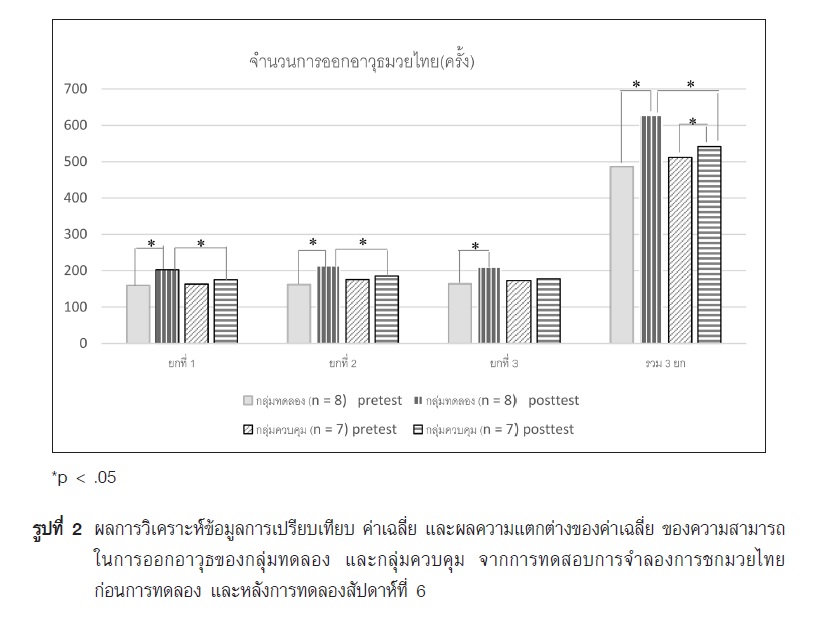EFFECT OF SUPPLEMENTED MUAY THAI CIRCUIT TRAINING PROGRAM ON MAXIMAL OXIGEN UPTAKE AND PHYSICAL PERFORMANCE IN PROFESSIONAL MUAY THAI BOXERS
Main Article Content
Abstract
Purpose : This research aimed to determine the effects of supplemented Muay Thai circuit training program on maximal oxygen uptake and physical performance in professional Muay Thai boxer.
Methods : Fifteen professional Muay Thai boxers, aged between 19-22 years old, volunteered for this study. They were divided into two groups; an experimental group (n=8) and a control group (n=7). The experimental group was trained by Muay Thai circuit training program in addition to their regular training, 3 days a week for 6 weeks, whereas the control group, underwent a regular training program only. Maximal oxygen uptake (VO2max) was measured by using a Bruce protocol and physical performance was tested using a simulation match of Muay Thai. Data were presented as mean and standard deviation, and were analyzed using Pair t-test and Independent sample-t test. A level of significant was set at p-value < 0.05.
Results : The results showed that after 6-week of training the experimental group had a greater improvements in VO2max and recovery heart rate during a simulation match of Muay Thai compared to pre training (p<0.05). In addition, the number of attack in the experimental group was higher than that of control group and pre training (p<0.05).
Conclusion : The Muay Thai circuit training program employed in the present study is effective and sport specific exercise program for improving maximal oxygen uptake and physical performance of professional Muay Thai boxer.
Article Details
References
Amtmann, J., and Cotton, A. (2005). Strength and conditioning for judo. Strength and Conditioning Journal, 27(2), 26.
Barnett, C., Carey, M., Proietto, J., Cerin, E., Febbraio, M. A., and Jenkins, D. (2004). Muscle metabolism during sprint exercise in man: influence of sprint training. Journal of Science and Medicine in Sport, 7(3), 314-322.
Buse, G. J., and Santana, J. C. (2008). Conditioning strategies for competitive kickboxing. Strength and Conditioning Journal, 30(4), 42-48.
Cappai, I., Pierantozzi, E., Tam, E., Tocco, F., Angius, L., Milia, R., Crisafulli, A. (2012). Physiological responses and match analysis of Muay Thai fighting. International Journal of Performance Analysis in Sport, 12(3), 507-516.
Crisafulli, A., Vitelli, S., Cappai, I., Milia, R., Tocco, F., Melis, F., and Concu, A. (2009). Physiological responses and energy cost during a simulation of a Muay Thai boxing match. Applied Physiology, Nutrition, and Metabolism, 34(2), 143-150.
De Lira, C. A. B., Peixinho-Pena, L. F., Vancini, R. L., Fachina, R. J. d. F. G., de Almeida, A. A., dos Santos Andrade, M., and da Silva, A. C. (2013). Heart rate response during a simulated Olympic boxing match is predominantly above ventilatory threshold 2: a cross sectional study. Open Access Journal of Sports Medicine, 4, 175.
Harris, N. K., Dulson, D. K., Logan, G. R., Warbrick, I. B., Merien, F. L., and Lubans, D. R. (2017). Acute Responses to Resistance and High-Intensity Interval Training in Early Adolescents. The Journal of Strength and Conditioning Research, 31(5), 1177-1186.
Kamandulis, S., Bruzas, V., Mockus, P., Stasiulis, A., Snieckus, A., and Venckunas, T. (2018). Sport-specific repeated sprint training improves punching ability and upper-body aerobic power in experienced amateur boxers. The Journal of Strength and Conditioning Research, 32(5), 1214-1221.
Khanna, G. L., and Manna, I. (2006). Study of physiological profile of Indian boxers. Journal of Sports Science and Medicine, 5(CSSI), 90.
Myers, T., Balmer, N., Nevill, A., & Al-Nakeeb, Y. (2013). Techniques used by elite Thai and UK Muay Thai fighters: An analysis and simulation. Advances in Physical Education, 3(04), 175.
Ouergui, I., Houcine, N., Marzouki, H., Davis, P., Zaouali, M., Franchini, E., Bouhlel, E. (2015). Development of a noncontact kickboxing circuit training protocol that simulates elite male kickboxing competition. The Journal of Strength and Conditioning Research, 29(12), 3405-3411.
Ouergui, I., Marzouki, H., Houcine, N., Franchini, E., Gmada, N., and Bouhlel, E. (2016). Relative and absolute reliability of specific kickboxing circuit training protocol in male kickboxers. Science and Sports, 31(4), e65-e72. doi:10.1016/j.scispo.2016.01.004
Schoenfeld, B., and Dawes, J. (2009). Highintensity interval training: Applications for general fitness training. Strength and Conditioning Journal, 31(6), 44-46.
Slimani, M., Miarka, B., Briki, W., and Cheour, F. (2016). Comparison of mental toughness and power test performances in high-level kickboxers by competitive success. Asian Journal of Sports Medicine, 7(2).
Trial, W., and Wu, T. (2014). A kinematic analysis of the Thai boxing clinch. Advances in Biomechanics and Applications, 1(1), 57-66. doi:10.12989/aba.2013.1.1.057
Turner, A. N. (2009). Strength and conditioning for Muay Thai athletes. Strength and Conditioning Journal, 31(6), 78-92.


